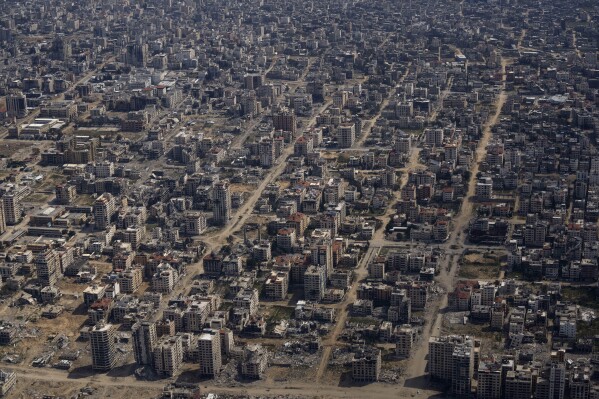While the wars in Gaza and Lebanon drag on the first reports about the rebuilding the day after the wars have ended have been published.
As regards Lebanon, a recent study by the international aid organisation Mercy Corps outlines two potential conflict scenarios and their economic and humanitarian consequences for the country. The report, published by its Lebanon Crisis Analysis Team (LCAT) and funded by among others the EU, can be read as an alarm signal to end the war in Lebanon before the situation becomes worse.
In Gaza, Hamas as a military force is already defeated, former Israeli defense minister Joav Gallant told the families of hostages taken by Hamas on 7 October. There is no military reason for Israel staying there and risking the lives of more soldiers. Gallant was fired last week by Prime-Minister Netanyahu for telling the truth.
Instead, the government has decided on a new offensive in northern Gaza to root out Hamas which had returned and filled the vacuum there. Humanitarian aid has been limited, more civilians have been displaced and what was left of buildings are destroyed. What is happening on the ground seems to pave the way for the annexation of northern Gaza as the extremists in the government are demanding.
Hamas could definitely be removed from power in Gaza if the current far-right Israeli government would agree to allowing an alternative in the form of a reformed Palestinian Authority and an international force in a post-Hamas Gaza. An increase in humanitarian assistance is urgent, so is also the rebuilding of Gaza.
The rebuilding could start already now but for this to happen the war must end and international donors become convinced that what is going to be built up will not be destroyed again. There must also be a better political perspective than Hamas can offer and for the moderate Arab countries to support the rebuilding.
The immense extent of destruction in the Gaza Strip requires massive rebuilding. A recent study published by an Israeli think tank (Mitvim - The Israeli Institute for Regional Foreign Policies) sets a vision of a long-term economic rebuilding plan, which also aims at ending the humanitarian crisis and creating a functioning and sustainable economy.
Mitvim is also known for the Israeli Initiative, a roadmap for an exit from the war and the transition to a two-state solution on the ground, which it published earlier this year. The new report on the reconstruction of Gaza was part of joint research projects with European partners and presented to EU decision makers in Brussels last July.
Did the EU show any interest in report? “They were interested but our impression at that time was that they were more interested in more urgent issues such as the fiscal situation of the Palestinian Authority,“ Yitzhak Gal, an economic and business consultant for the Middle East who co-wrote the study with Dr. Maya Sion-Tzidkiyahu, told The Brussels Times.
Currently, the Palestinian Authority is dependent on tax revenues collected by Israel on its behalf. The report foresees that the Authority will not need these revenues if and when its economic dependence on Israel will be reduced in the framework of the reconstruction of Gaza and the new projects it will booster.
The costs for rebuilding Gaza from scratch are estimated to €60 – €75 billion and it would take up to 10 years. Did you consider any alternative to rebuilding Gaza? “There is hardly any alternative,” Gal replied. “The Palestinians in Gaza have no other place to go to so Gaza must be rebuilt. What would be so costs of not rebuilding?”
Is there space in the overcrowded Gaza Strip to build a better and sustainable future? Gal is open to land swaps and mentions the plans discussed between former Israeli prime minister, Ehud Olmert, and Palestinian president Mahmud Abbas. Adding land from Sinai, which was annexed to Egypt in colonial times by the British and the Ottomans, is a sensitive issue for Egypt but not totally out of the question.
The Egyptian government fears that displaced Gazans will become radicalized and join militant groups in Sinai. But there are precedents in the Middle East where areas have been handed over without the change of status, for example leasing arrangements. He mentioned the agreement between Egypt and Saudi Arabia, where Egypt handed over a small island.
Egypt could be willing to agree to such a solution. Such areas could be used as industrial zones and agricultural areas while most of the population continues to live in Gaza.
What can Israel do to enable the population to live under decent conditions during the rebuilding period? “The Palestinian Authority has already planned for building temporary housing while simultaneously permanent housing is built in Gaza,” he replied. “There are also plans for rebuilding the infrastructure.”
“Israel could definitely help, e.g. building field hospitals on both sides of the border.” Furthermore, there are feasibility studies, that only need to be updated, for game-changing mega-projects. By building back better, Gaza would be transformed and the Palestinian economy would not be so dependent on Israel.”
Can a smaller version of the rebuilding plan get started without the necessary political conditions in place? “In my view, it’s impossible,” Gal replied. “Effective aid delivery requires that an international body or a revitalized Palestinian Authority takes control of Gaza. Otherwise, Hamas will come back and there will be chaos and insecurity. There is no way of getting round this problem.”
Could the EU play a major role in the rebuilding, both as payer and player? “This is very important. EU must move forward because it’s probably the most rational actor. It should change its position. Now it is perceived as a modest player and mostly a provider of financial assistance.”
The current European Commission has its own principal advisor, Henrike Trautmann, at Directorate-General for Neighborhood and Enlargement (DG NEAR), for the reconstruction of Gaza but she did not respond to requests for comments. The European External Action Service (EEAS) declined to comment on the study.


